Abstract
1. The relative proportions of beta 1- and beta 2-adrenoceptors were determined by radioligand binding studies in three different rat myocardial preparations: membranes prepared from rat ventricle (ventricular membranes), membranes prepared from rat isolated ventricular myocytes (myocyte membranes), and myocytes isolated from rat ventricle (myocytes). 2. Competition experiments using CGP 20712A or ICI 118,551 with [125I]-iodocyanopindolol ([125I]-ICYP) revealed high- and low-affinity binding sites in ventricular membranes. The concentration at which each beta-antagonist occupied 100% of its high-affinity binding sites was 300 nM for CGP 20712A (beta 1-adrenoceptor) and 50 nM for ICI 118,551 (beta 2-adrenoceptor). 3. The density of high-affinity (beta 1-adrenoceptor) and low-affinity (beta 2-adrenoceptor) binding sites for CGP 20712A was measured by a saturation experiment using [125I]-ICYP in the presence and absence of 300 nM CGP 20712A. In ventricular membranes, the proportions of high-affinity and low-affinity binding sites for CGP 20712A were 73% and 27%, respectively, whereas in myocyte membranes, the corresponding figures were 90% and 10%, respectively. The density of low-affinity binding sites for CGP 20712A in ventricular membranes, defined as [125I]-ICYP-specific binding in the presence of 300 nM CGP 20712A, was decreased by addition of 50 nM ICI 118,551, whereas that in myocyte membranes was not affected. 4. In myocytes, specific binding of [125I]-ICYP and [3H]-CGP 12177 was not detected by saturation experiments performed in the presence of 300 nM CGP 20712A.(ABSTRACT TRUNCATED AT 250 WORDS)
Full text
PDF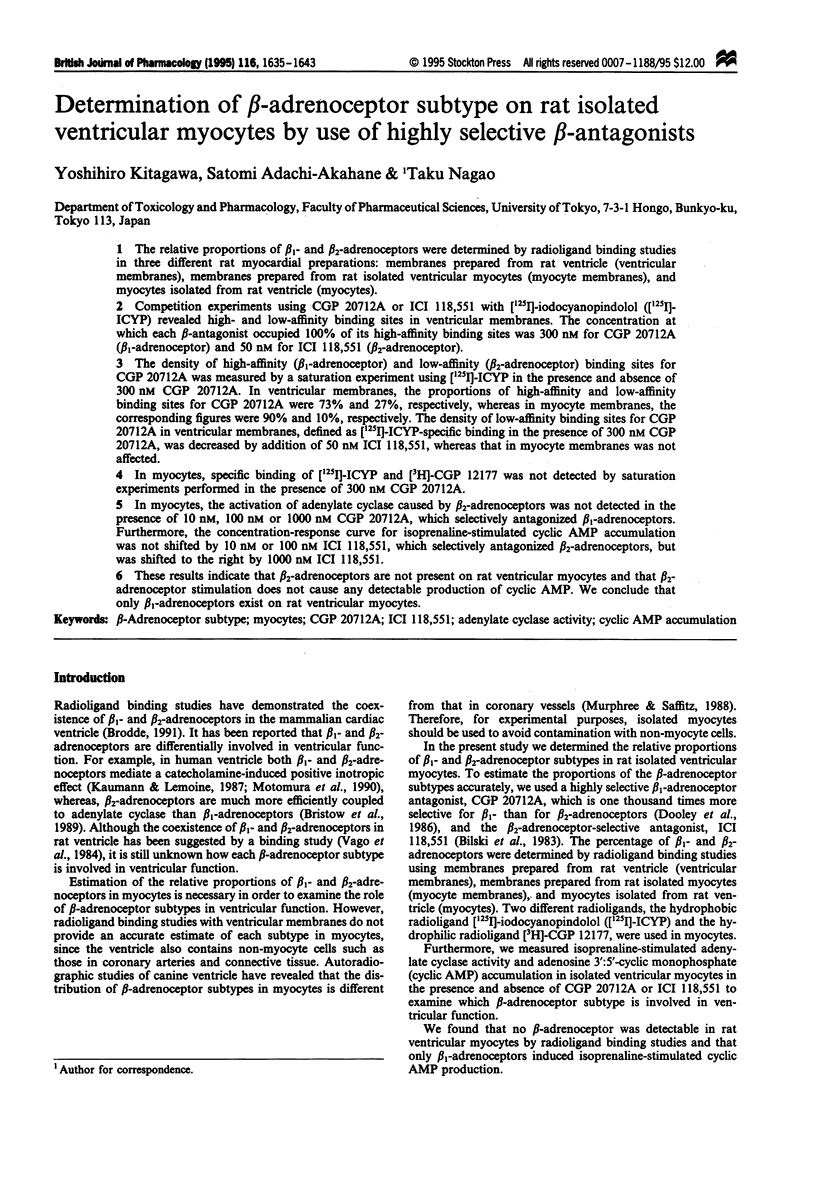

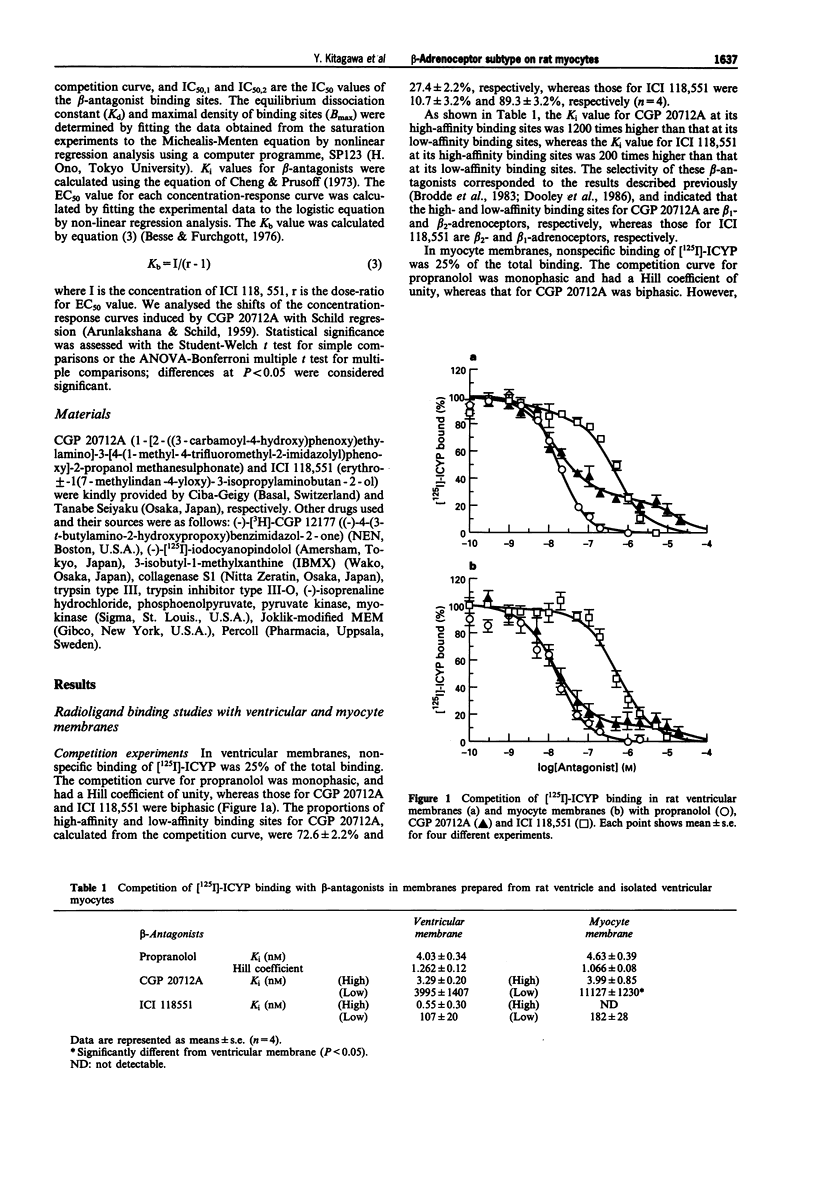
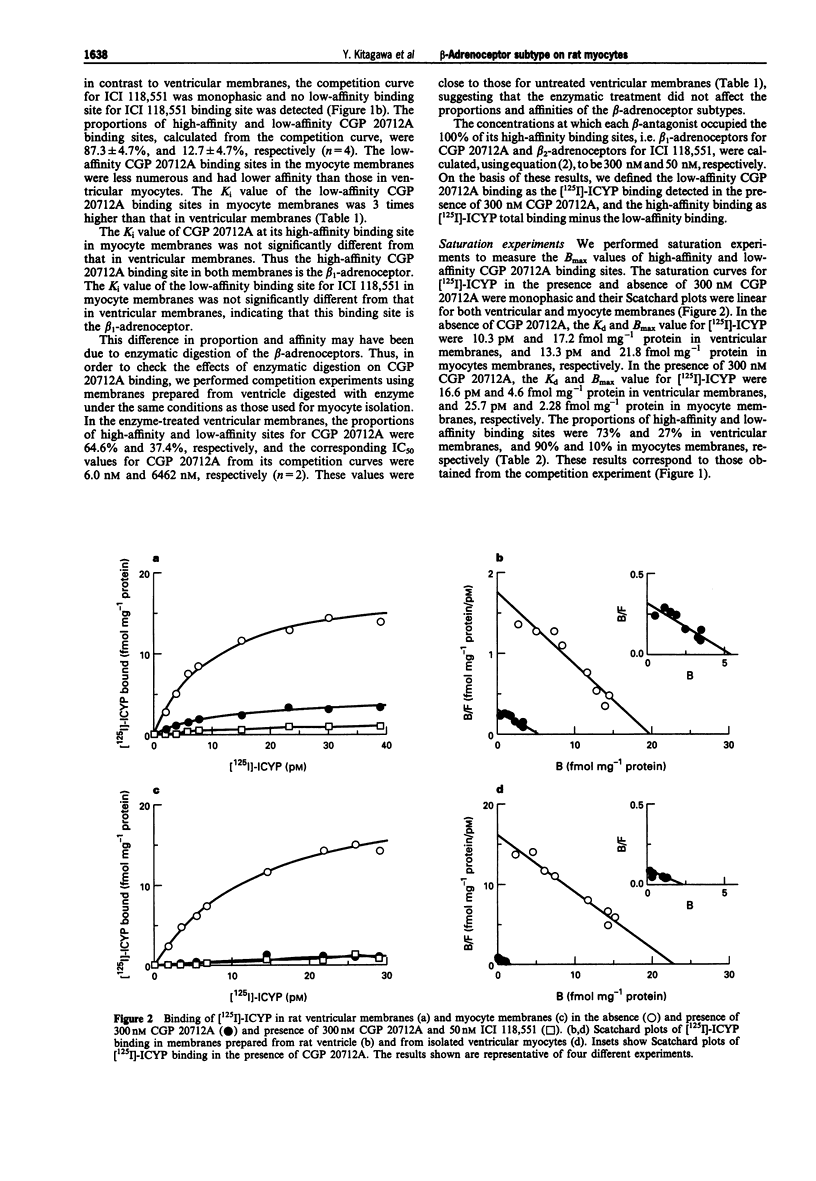

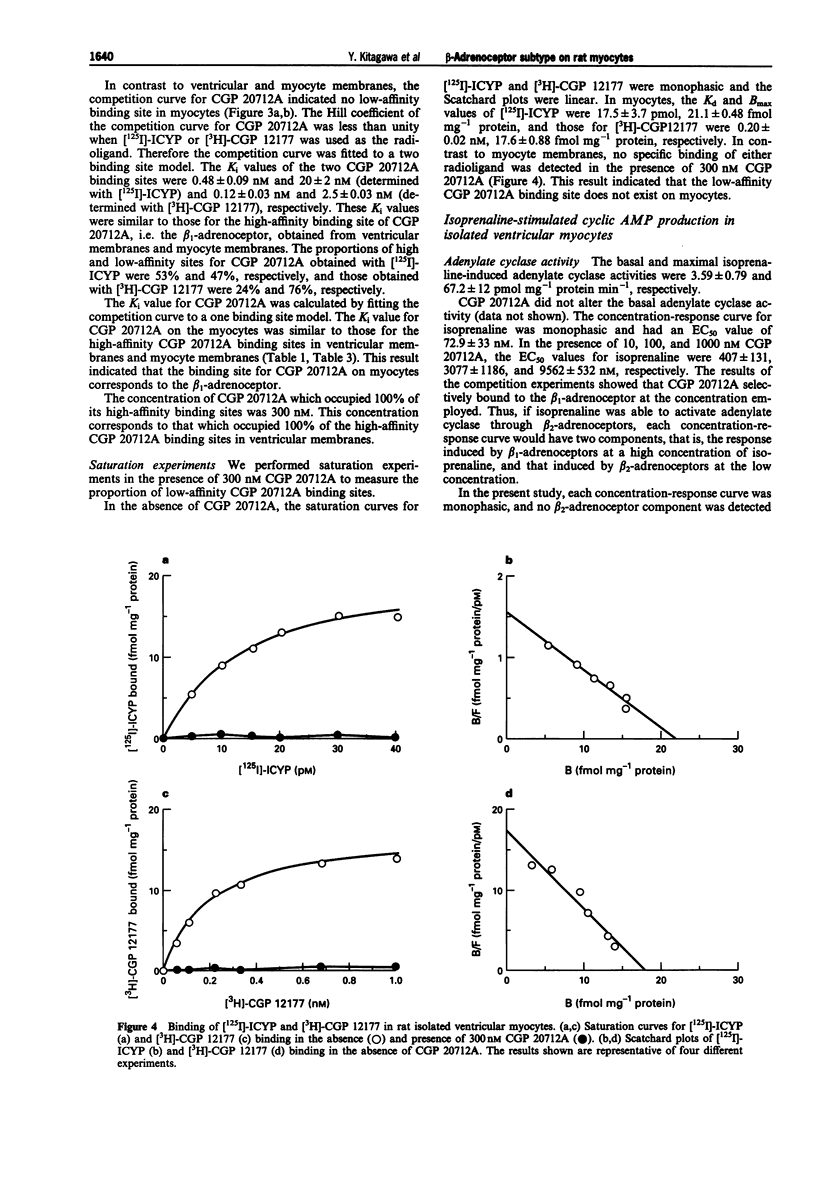
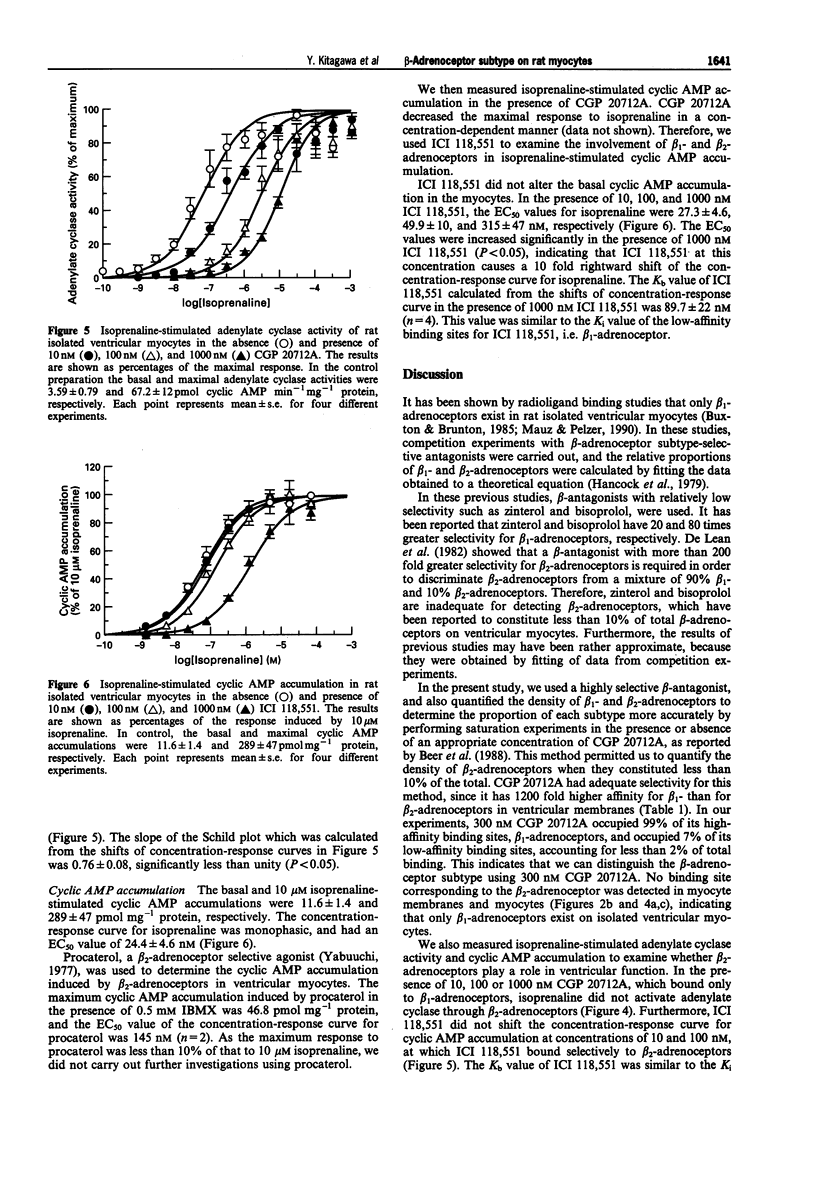
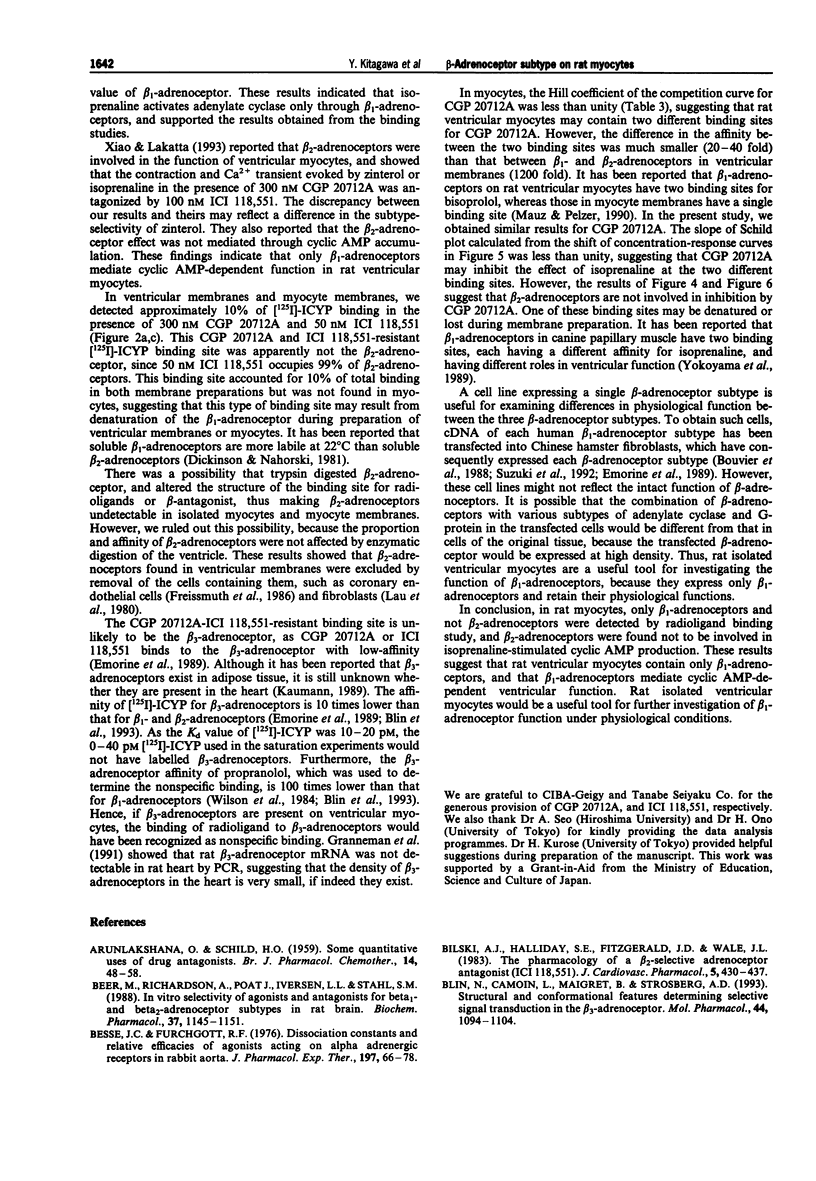
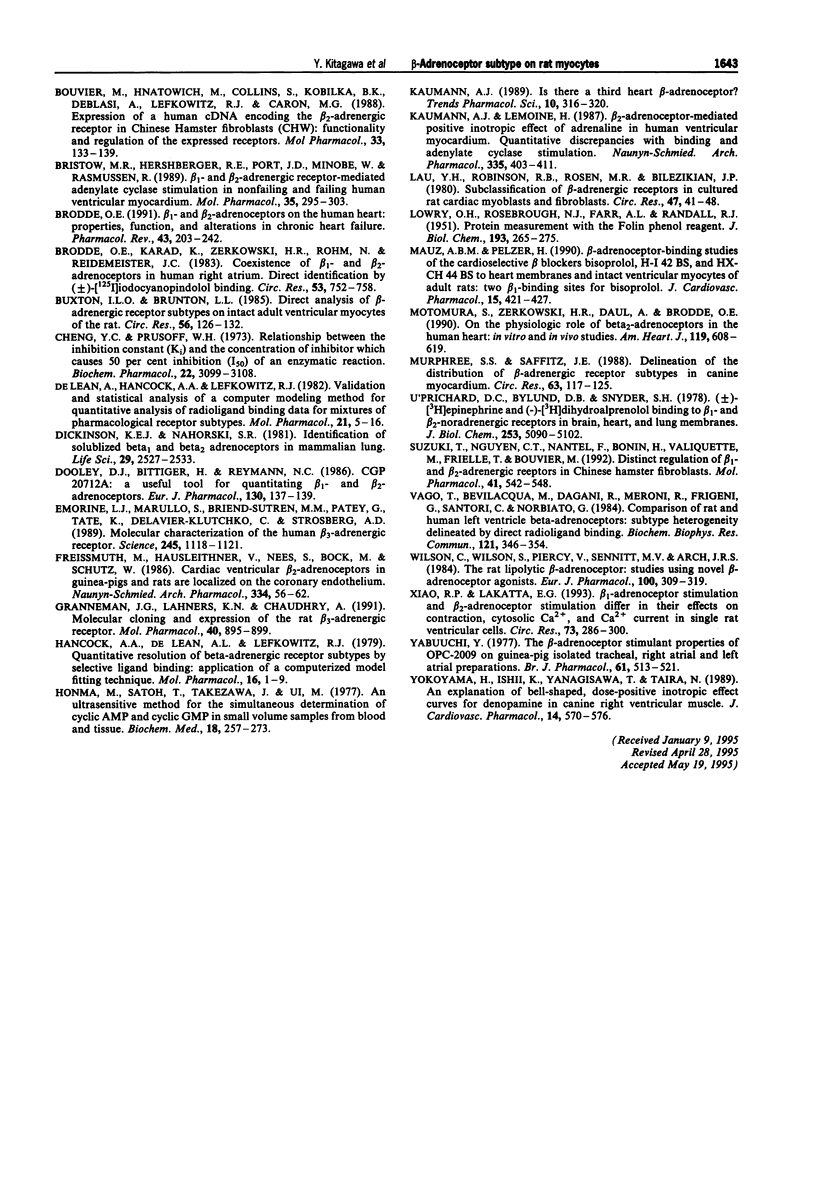
Selected References
These references are in PubMed. This may not be the complete list of references from this article.
- ARUNLAKSHANA O., SCHILD H. O. Some quantitative uses of drug antagonists. Br J Pharmacol Chemother. 1959 Mar;14(1):48–58. doi: 10.1111/j.1476-5381.1959.tb00928.x. [DOI] [PMC free article] [PubMed] [Google Scholar]
- Beer M., Richardson A., Poat J., Iversen L. L., Stahl S. M. In vitro selectivity of agonists and antagonists for beta 1- and beta 2-adrenoceptor subtypes in rat brain. Biochem Pharmacol. 1988 Mar 15;37(6):1145–1151. doi: 10.1016/0006-2952(88)90523-0. [DOI] [PubMed] [Google Scholar]
- Besse J. C., Furchgott R. F. Dissociation constants and relative efficacies of agonists acting on alpha adrenergic receptors in rabbit aorta. J Pharmacol Exp Ther. 1976 Apr;197(1):66–78. [PubMed] [Google Scholar]
- Bilski A. J., Halliday S. E., Fitzgerald J. D., Wale J. L. The pharmacology of a beta 2-selective adrenoceptor antagonist (ICI 118,551). J Cardiovasc Pharmacol. 1983 May-Jun;5(3):430–437. doi: 10.1097/00005344-198305000-00013. [DOI] [PubMed] [Google Scholar]
- Blin N., Camoin L., Maigret B., Strosberg A. D. Structural and conformational features determining selective signal transduction in the beta 3-adrenergic receptor. Mol Pharmacol. 1993 Dec;44(6):1094–1104. [PubMed] [Google Scholar]
- Bouvier M., Hnatowich M., Collins S., Kobilka B. K., Deblasi A., Lefkowitz R. J., Caron M. G. Expression of a human cDNA encoding the beta 2-adrenergic receptor in Chinese hamster fibroblasts (CHW): functionality and regulation of the expressed receptors. Mol Pharmacol. 1988 Feb;33(2):133–139. [PubMed] [Google Scholar]
- Bristow M. R., Hershberger R. E., Port J. D., Minobe W., Rasmussen R. Beta 1- and beta 2-adrenergic receptor-mediated adenylate cyclase stimulation in nonfailing and failing human ventricular myocardium. Mol Pharmacol. 1989 Mar;35(3):295–303. [PubMed] [Google Scholar]
- Brodde O. E. Beta 1- and beta 2-adrenoceptors in the human heart: properties, function, and alterations in chronic heart failure. Pharmacol Rev. 1991 Jun;43(2):203–242. [PubMed] [Google Scholar]
- Brodde O. E., Karad K., Zerkowski H. R., Rohm N., Reidemeister J. C. Coexistence of beta 1- and beta 2-adrenoceptors in human right atrium. Direct identification by (+/-)-[125I]iodocyanopindolol binding. Circ Res. 1983 Dec;53(6):752–758. doi: 10.1161/01.res.53.6.752. [DOI] [PubMed] [Google Scholar]
- Buxton I. L., Brunton L. L. Direct analysis of beta-adrenergic receptor subtypes on intact adult ventricular myocytes of the rat. Circ Res. 1985 Jan;56(1):126–132. doi: 10.1161/01.res.56.1.126. [DOI] [PubMed] [Google Scholar]
- Cheng Y., Prusoff W. H. Relationship between the inhibition constant (K1) and the concentration of inhibitor which causes 50 per cent inhibition (I50) of an enzymatic reaction. Biochem Pharmacol. 1973 Dec 1;22(23):3099–3108. doi: 10.1016/0006-2952(73)90196-2. [DOI] [PubMed] [Google Scholar]
- De Lean A., Hancock A. A., Lefkowitz R. J. Validation and statistical analysis of a computer modeling method for quantitative analysis of radioligand binding data for mixtures of pharmacological receptor subtypes. Mol Pharmacol. 1982 Jan;21(1):5–16. [PubMed] [Google Scholar]
- Dickinson K. E., Nahorski S. R. Identification of solubilised beta 1 and beta 2 adrenoceptors in mammalian lung. Life Sci. 1981 Dec 14;29(24):2527–2533. doi: 10.1016/0024-3205(81)90708-6. [DOI] [PubMed] [Google Scholar]
- Dooley D. J., Bittiger H., Reymann N. C. CGP 20712 A: a useful tool for quantitating beta 1- and beta 2-adrenoceptors. Eur J Pharmacol. 1986 Oct 14;130(1-2):137–139. doi: 10.1016/0014-2999(86)90193-7. [DOI] [PubMed] [Google Scholar]
- Emorine L. J., Marullo S., Briend-Sutren M. M., Patey G., Tate K., Delavier-Klutchko C., Strosberg A. D. Molecular characterization of the human beta 3-adrenergic receptor. Science. 1989 Sep 8;245(4922):1118–1121. doi: 10.1126/science.2570461. [DOI] [PubMed] [Google Scholar]
- Freissmuth M., Hausleithner V., Nees S., Böck M., Schütz W. Cardiac ventricular beta 2-adrenoceptors in guinea-pigs and rats are localized on the coronary endothelium. Naunyn Schmiedebergs Arch Pharmacol. 1986 Sep;334(1):56–62. doi: 10.1007/BF00498740. [DOI] [PubMed] [Google Scholar]
- Granneman J. G., Lahners K. N., Chaudhry A. Molecular cloning and expression of the rat beta 3-adrenergic receptor. Mol Pharmacol. 1991 Dec;40(6):895–899. [PubMed] [Google Scholar]
- Hancock A. A., DeLean A. L., Lefkowitz R. J. Quantitative resolution of beta-adrenergic receptor subtypes by selective ligand binding: application of a computerized model fitting technique. Mol Pharmacol. 1979 Jul;16(1):1–9. [PubMed] [Google Scholar]
- Honma M., Satoh T., Takezawa J., Ui M. An ultrasensitive method for the simultaneous determination of cyclic AMP and cyclic GMP in small-volume samples from blood and tissue. Biochem Med. 1977 Dec;18(3):257–273. doi: 10.1016/0006-2944(77)90060-6. [DOI] [PubMed] [Google Scholar]
- Kaumann A. J. Is there a third heart beta-adrenoceptor? Trends Pharmacol Sci. 1989 Aug;10(8):316–320. doi: 10.1016/0165-6147(89)90065-5. [DOI] [PubMed] [Google Scholar]
- Kaumann A. J., Lemoine H. Beta 2-adrenoceptor-mediated positive inotropic effect of adrenaline in human ventricular myocardium. Quantitative discrepancies with binding and adenylate cyclase stimulation. Naunyn Schmiedebergs Arch Pharmacol. 1987 Apr;335(4):403–411. doi: 10.1007/BF00165555. [DOI] [PubMed] [Google Scholar]
- LOWRY O. H., ROSEBROUGH N. J., FARR A. L., RANDALL R. J. Protein measurement with the Folin phenol reagent. J Biol Chem. 1951 Nov;193(1):265–275. [PubMed] [Google Scholar]
- Lau Y. H., Robinson R. B., Rosen M. R., Bilezikian J. P. Subclassification of beta-adrenergic receptors in cultured rat cardiac myoblasts and fibroblasts. Circ Res. 1980 Jul;47(1):41–48. doi: 10.1161/01.res.47.1.41. [DOI] [PubMed] [Google Scholar]
- Mauz A. B., Pelzer H. Beta-adrenoceptor-binding studies of the cardioselective beta blockers bisoprolol, H-I 42 BS, and HX-CH 44 BS to heart membranes and intact ventricular myocytes of adult rats: two beta 1-binding sites for bisoprolol. J Cardiovasc Pharmacol. 1990 Mar;15(3):421–427. doi: 10.1097/00005344-199003000-00012. [DOI] [PubMed] [Google Scholar]
- Motomura S., Reinhard-Zerkowski H., Daul A., Brodde O. E. On the physiologic role of beta-2 adrenoceptors in the human heart: in vitro and in vivo studies. Am Heart J. 1990 Mar;119(3 Pt 1):608–619. doi: 10.1016/s0002-8703(05)80284-4. [DOI] [PubMed] [Google Scholar]
- Murphree S. S., Saffitz J. E. Delineation of the distribution of beta-adrenergic receptor subtypes in canine myocardium. Circ Res. 1988 Jul;63(1):117–125. doi: 10.1161/01.res.63.1.117. [DOI] [PubMed] [Google Scholar]
- Suzuki T., Nguyen C. T., Nantel F., Bonin H., Valiquette M., Frielle T., Bouvier M. Distinct regulation of beta 1- and beta 2-adrenergic receptors in Chinese hamster fibroblasts. Mol Pharmacol. 1992 Mar;41(3):542–548. [PubMed] [Google Scholar]
- U'Prichard D. C., Bylund D. B., Snyder S. H. (+/-)-[3H]Epinephrine and (-)[3H]dihydroalprenolol binding to beta1- and beta2-noradrenergic receptors in brain, heart, and lung membranes. J Biol Chem. 1978 Jul 25;253(14):5090–5102. [PubMed] [Google Scholar]
- Vago T., Bevilacqua M., Dagani R., Meroni R., Frigeni G., Santoliss C., Norbiato G. Comparison of rat and human left ventricle beta-adrenergic receptors: subtype heterogeneity delineated by direct radioligand binding. Biochem Biophys Res Commun. 1984 May 31;121(1):346–354. doi: 10.1016/0006-291x(84)90729-0. [DOI] [PubMed] [Google Scholar]
- Wilson C., Wilson S., Piercy V., Sennitt M. V., Arch J. R. The rat lipolytic beta-adrenoceptor: studies using novel beta-adrenoceptor agonists. Eur J Pharmacol. 1984 May 4;100(3-4):309–319. doi: 10.1016/0014-2999(84)90007-4. [DOI] [PubMed] [Google Scholar]
- Xiao R. P., Lakatta E. G. Beta 1-adrenoceptor stimulation and beta 2-adrenoceptor stimulation differ in their effects on contraction, cytosolic Ca2+, and Ca2+ current in single rat ventricular cells. Circ Res. 1993 Aug;73(2):286–300. doi: 10.1161/01.res.73.2.286. [DOI] [PubMed] [Google Scholar]
- Yabuuchi Y. The beta-adrenoceptor stimulant properties of OPC-2009 on guinea-pig isolated tracheal, right atrial and left atrial preparations. Br J Pharmacol. 1977 Dec;61(4):513–521. doi: 10.1111/j.1476-5381.1977.tb07543.x. [DOI] [PMC free article] [PubMed] [Google Scholar]
- Yokoyama H., Ishii K., Yanagisawa T., Taira N. An explanation of bell-shaped, dose-positive inotropic effect curves for denopamine in canine right ventricular muscle. J Cardiovasc Pharmacol. 1989 Oct;14(4):570–576. doi: 10.1097/00005344-198910000-00008. [DOI] [PubMed] [Google Scholar]


